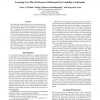Free Online Productivity Tools
i2Speak
i2Symbol
i2OCR
iTex2Img
iWeb2Print
iWeb2Shot
i2Type
iPdf2Split
iPdf2Merge
i2Bopomofo
i2Arabic
i2Style
i2Image
i2PDF
iLatex2Rtf
Sci2ools
AIPS
2009
2009
Learning User Plan Preferences Obfuscated by Feasibility Constraints
It has long been recognized that users can have complex preferences on plans. Non-intrusive learning of such preferences by observing the plans executed by the user is an attractive idea. Unfortunately, the executed plans are often not a true representation of user preferences, as they result from the interaction between user preferences and feasibility constraints. In the travel planning scenario, a user whose true preference is to travel by a plane may well be frequently observed traveling by car because of feasibility constraints (perhaps the user is a poor graduate student). In this work, we describe a novel method for learning true user preferences obfuscated by such feasibility constraints. Our base learner induces probabilistic hierarchical task networks (pHTNs) from sets of training plans. Our approach is to rescale the input so that it represents the user's preference distribution on plans rather than the observed distribution on plans.
AIPS 2009 | Artificial Intelligence | Feasibility Constraints | True User Preferences | User Preferences |
| Added | 08 Nov 2010 |
| Updated | 08 Nov 2010 |
| Type | Conference |
| Year | 2009 |
| Where | AIPS |
| Authors | Nan Li, William Cushing, Subbarao Kambhampati, Sung Wook Yoon |
Comments (0)

